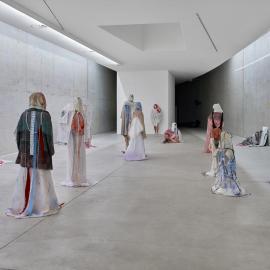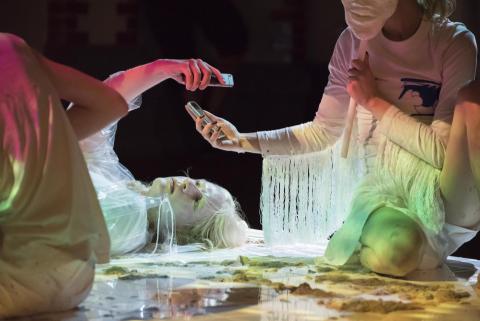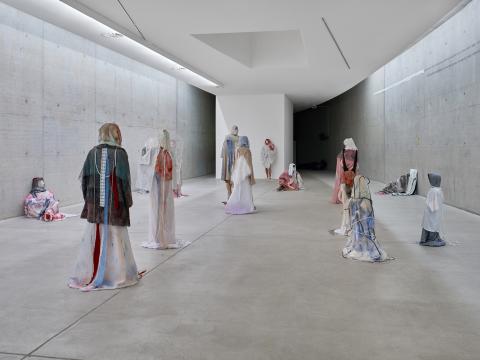Isabella Fürnkäs
http://isabellafuernkaes.com/

Born 1988 in Tokyo, Japan. Lives and works in Berlin, Germany.
Isabella Fürnkäs is an artist who works in a variety of media. The body of work involves equal shares of video, multi-media installation, performance and drawing. In her work she deals with questions of bodily intimacy, digital relationality and the fragility of societal communication structures. By manipulating the viewer, Fürnkäs creates contextual shifts that echo our own vulnerabilities. In the context of her works, inner images and multi-layered questions are transformed into a repertoire of media-reflexive actions. She is the recipient of the Förderpreis des Landes NRW and of the Paris Cité des Arts grant. In 2019 she was the stipend of the Bronner residency for Tel Aviv, in 2018 a residency of the Goethe Institute Dakar, and in 2017 she received a travel grant from the Kunstverein für die Rheinlande und Westfalen. Her work was exhibited at Kunsthalle Wien, Sprengel Museum, Museum Abteiberg, at the 13. Biennale for Contemporary Art Dakar and in the project space of the Julia Stoschek Collection in Düsseldorf. Her Performances were recently on view at Salon Acme in Mexico City, Kölnischen Kunstverein, Manifesta 11, Akademie der Künste der Welt and KW Institute for Contemporary Art Berlin.
About the exhibited work
In the age of full-blown consumerism and ideological inertia, individual identity is primarily communicated through labels with which an imagined self is positioned and valorised. The different needs and constraints result in a patchwork of veiling self-dramatisation, an anomythic hide-and-seek game of surfaces in which analogue and virtual individuals threaten to collapse. The complexity and diversity of semiotic references form a cross-milieu system that can no longer be penetrated individually and leaves its bearers behind. In the context of the sound collage, the voices of the latter - once the medium with which self-image and self-assurance were communicated - become a barely perceptible whispering, speaking and singing, which at the same time invites direct sensory experience as a stream of consciousness and negotiates questions of role-playing, isolation, interpersonal communication and social co-existence.
"Human-like figures, magnificently draped in colours and patterns, nourished by their engagement with Japanese theatre and arts and crafts; with the appearance of having grown out of painting, populate spaces and, in a limp, melting state, pour colourfully across the floor, becoming drawing again." - Andreas Reihse
The main impulse for the first version of the installation "Unpredictable Liars" (2017) comes inspired by Japanese Nō theatre, which already has inherent loss of the individual through the use of centuries-old symbols. Another version was formed in 2018-19 with the series "Unpredictable Liars II", where the ghostly transhuman characters seem like the last survivors of a utopia. In the new series "Unpredictable Liars REVOLT" (2021), the figures have been encased in epoxy, which further emphasises the congealed character of their disguise, devoid of meaning and stripped of interhumanity.
Text by Matthias Jakob Becker
Isabella Fürnkäs is an artist who works in a variety of media. The body of work involves equal shares of video, multi-media installation, performance and drawing. In her work she deals with questions of bodily intimacy, digital relationality and the fragility of societal communication structures. By manipulating the viewer, Fürnkäs creates contextual shifts that echo our own vulnerabilities. In the context of her works, inner images and multi-layered questions are transformed into a repertoire of media-reflexive actions. She is the recipient of the Förderpreis des Landes NRW and of the Paris Cité des Arts grant. In 2019 she was the stipend of the Bronner residency for Tel Aviv, in 2018 a residency of the Goethe Institute Dakar, and in 2017 she received a travel grant from the Kunstverein für die Rheinlande und Westfalen. Her work was exhibited at Kunsthalle Wien, Sprengel Museum, Museum Abteiberg, at the 13. Biennale for Contemporary Art Dakar and in the project space of the Julia Stoschek Collection in Düsseldorf. Her Performances were recently on view at Salon Acme in Mexico City, Kölnischen Kunstverein, Manifesta 11, Akademie der Künste der Welt and KW Institute for Contemporary Art Berlin.
About the exhibited work
In the age of full-blown consumerism and ideological inertia, individual identity is primarily communicated through labels with which an imagined self is positioned and valorised. The different needs and constraints result in a patchwork of veiling self-dramatisation, an anomythic hide-and-seek game of surfaces in which analogue and virtual individuals threaten to collapse. The complexity and diversity of semiotic references form a cross-milieu system that can no longer be penetrated individually and leaves its bearers behind. In the context of the sound collage, the voices of the latter - once the medium with which self-image and self-assurance were communicated - become a barely perceptible whispering, speaking and singing, which at the same time invites direct sensory experience as a stream of consciousness and negotiates questions of role-playing, isolation, interpersonal communication and social co-existence.
"Human-like figures, magnificently draped in colours and patterns, nourished by their engagement with Japanese theatre and arts and crafts; with the appearance of having grown out of painting, populate spaces and, in a limp, melting state, pour colourfully across the floor, becoming drawing again." - Andreas Reihse
The main impulse for the first version of the installation "Unpredictable Liars" (2017) comes inspired by Japanese Nō theatre, which already has inherent loss of the individual through the use of centuries-old symbols. Another version was formed in 2018-19 with the series "Unpredictable Liars II", where the ghostly transhuman characters seem like the last survivors of a utopia. In the new series "Unpredictable Liars REVOLT" (2021), the figures have been encased in epoxy, which further emphasises the congealed character of their disguise, devoid of meaning and stripped of interhumanity.
Text by Matthias Jakob Becker



